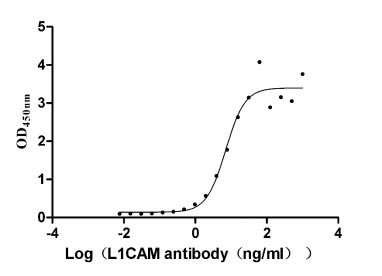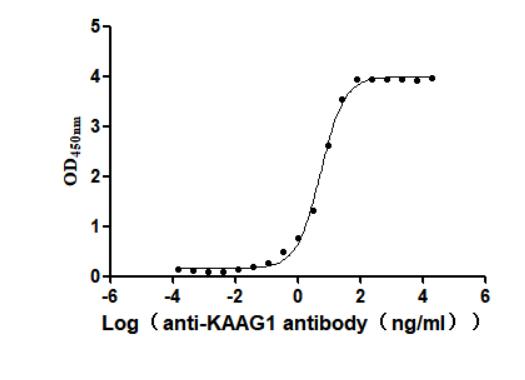Recombinant Human Desmoglein-3 (DSG3), partial
In Stock-
中文名稱:人DSG3重組蛋白
-
貨號:CSB-EP007205HU(A5)
-
規(guī)格:¥1344
-
圖片:
-
其他:
產(chǎn)品詳情
-
純度:Greater than 90% as determined by SDS-PAGE.
-
基因名:DSG3
-
Uniprot No.:
-
別名:130 kD pemphigus vulgaris antigen; 130 kDa pemphigus vulgaris antigen; Balding; Cadherin family member 6; CDHF 6; CDHF6; Desmoglein 3; Desmoglein 3 precursor; Desmoglein-3; Desmoglein3; DKFZp686P23184; DSG 3; DSG3; DSG3_HUMAN; Pemphigus vulgaris antigen; PVA
-
種屬:Homo sapiens (Human)
-
蛋白長度:Partial
-
來源:E.coli
-
分子量:76.6kDa
-
表達(dá)區(qū)域:70-615aa
-
氨基酸序列IAKITSDYQATQKITYRISGVGIDQPPFGIFVVDKNTGDINITAIVDREETPSFLITCRALNAQGLDVEKPLILTVKILDINDNPPVFSQQIFMGEIEENSASNSLVMILNATDADEPNHLNSKIAFKIVSQEPAGTPMFLLSRNTGEVRTLTNSLDREQASSYRLVVSGADKDGEGLSTQCECNIKVKDVNDNFPMFRDSQYSARIEENILSSELLRFQVTDLDEEYTDNWLAVYFFTSGNEGNWFEIQTDPRTNEGILKVVKALDYEQLQSVKLSIAVKNKAEFHQSVISRYRVQSTPVTIQVINVREGIAFRPASKTFTVQKGISSKKLVDYILGTYQAIDEDTNKAASNVKYVMGRNDGGYLMIDSKTAEIKFVKNMNRDSTFIVNKTITAEVLAIDEYTGKTSTGTVYVRVPDFNDNCPTAVLEKDAVCSSSPSVVVSARTLNNRYTGPYTFALEDQPVKLPAVWSITTLNATSALLRAQEQIPPGVYHISLVLTDSQNNRCEMPRSLTLEVCQCDNRGICGTSYPTTSPGTRYGRPHSGR
Note: The complete sequence including tag sequence, target protein sequence and linker sequence could be provided upon request. -
蛋白標(biāo)簽:N-terminal 6xHis-SUMO-tagged
-
產(chǎn)品提供形式:Liquid or Lyophilized powder
Note: We will preferentially ship the format that we have in stock, however, if you have any special requirement for the format, please remark your requirement when placing the order, we will prepare according to your demand. -
緩沖液:Tris-based buffer,50% glycerol
-
儲存條件:Store at -20°C/-80°C upon receipt, aliquoting is necessary for mutiple use. Avoid repeated freeze-thaw cycles.
-
保質(zhì)期:The shelf life is related to many factors, storage state, buffer ingredients, storage temperature and the stability of the protein itself.
Generally, the shelf life of liquid form is 6 months at -20°C/-80°C. The shelf life of lyophilized form is 12 months at -20°C/-80°C. -
貨期:3-7 business days
-
注意事項(xiàng):Repeated freezing and thawing is not recommended. Store working aliquots at 4°C for up to one week.
-
Datasheet & COA:Please contact us to get it.
相關(guān)產(chǎn)品
靶點(diǎn)詳情
-
功能:Component of intercellular desmosome junctions. Involved in the interaction of plaque proteins and intermediate filaments mediating cell-cell adhesion.
-
基因功能參考文獻(xiàn):
- flotillin has a role in desmosomal adhesion and Pemphigus vulgaris-like localisation of desmoglein-3 in human keratinocytes PMID: 27346727
- our findings suggest that Dsg3 functions as a key in cell-cell adhesion through at least a mechanism of regulating E-cadherin membrane trafficking PMID: 27254775
- Desmoglein 3 Order and Dynamics in Desmosomes PMID: 29212005
- Data indicate that all 3 monoclonal antibodies (mAbs) targeted the same extracellular cadherin (EC) domain on desmoglein 3 (Dsg3), caused Dsg3 internalization in primary keratinocytes, and caused suprabasal blisters in skin. PMID: 27304671
- DSG3 was a key prognostic factor and predictor for neoadjuvant concurrent chemoradiotherapy response in rectal cancer patients. PMID: 27040321
- Treg cells exert a clear down-regulatory effect on the Dsg3-driven T-cell response and, accordingly, the formation of Dsg3-specific IgG antibodies PMID: 26661498
- Data identify DSG3 as a negative prognostic biomarker in resected pancreatic ductal adenocarcinoma, as high DSG3 expression is associated with poor overall survival and poor tumour-specific survival. PMID: 26469831
- this study directly demonstrates the occurrence of desmoglein 3 molecules outside of desmosomes and reveales that the adhesive properties of these molecules do differ depending on their localization. PMID: 25510735
- DSG2 and DSG3 might be potential diagnostic markers for squamous cell carcinoma of the lung and DSG3 could be a potential differentiation marker for lung cancer. PMID: 25468811
- alterations of their expression suggest a role of Dsg3 and gamma-catenin (additionally to E-cadherin/beta-catenin) as biomarkers of malignant transformation risk of oral dysplasia and the biological behavior (aggressiveness) of oral cancer, respectively PMID: 23430339
- the Dsg3 epitopes targeted by pathogenic mPV IgG are human specific in mice PMID: 25695683
- Pemphigus vulgaris is characterized by low IgG reactivities to specific self-antigens along with high IgG reactivity to desmoglein 3. PMID: 24820664
- High DSG3 mRNA expression is associated with esophageal squamous cell carcinoma. PMID: 24568510
- Pemphigus vulgaris autoimmune globulin induces Src-dependent tyrosine-phosphorylation of PKP3 and its detachment from DSG3. PMID: 24328683
- Dsg3 did not associate with rafts in cells lacking desmosomal proteins. PMID: 24498201
- this study identifies a novel Dsg3-mediated c-Jun/AP-1 regulatory mechanism and PKC-dependent Ezrin phosphorylation that could be responsible for Dsg3-associated cancer metastasis. PMID: 23752190
- DSG3 functions as an oncogene and facilitates cancer growth and invasion in head and neck cancer cells PMID: 23737966
- The conformational Dsg3 ELISA index reflected the pathogenicity of anti-Dsg3 antibodies more accurately than the conventional Dsg3 ELISA index in pemphigus vulgaris. PMID: 23602628
- MAC387 and desmoglein-3 are reliable diagnostic markers for supporting the morphologic impression of squamous differentiation in urinary bladder carcinoma. PMID: 23806524
- All 3 markers were studied independently and were associated with tumor percentage in metastatic lymph nodes. PVA had the strongest correlation, followed by PTHrP and then TACSTD1. PMID: 23625795
- provide a proof of principle supporting that ultrasensitive nanostructured assay systems for DSG3 can be exploited to detect micrometastatic HNSCC lesions in lymph nodes, which can improve the diagnosis PMID: 23010602
- The cis-adhesive interface on extracellular subdomain EC1 recognized by the pathogenic antibody PVA224 is the primary target of the autoantibodies present in the serum of pemiphigus vulgaris patients. PMID: 22996451
- an important novel function for Dsg3 in promoting actin dynamics through regulating Rac1 and Cdc42 activation in epithelial cells. PMID: 22796473
- a useful immunohistochemical marker for differentiation of lung squamous cell carcinoma and adenocarcinoma from other subtypes PMID: 22495379
- In paraneoplastic pempigus and pemphigus vulgaris, IgG autoantibodies to DSG3 may be found in autoantibody profiling. PMID: 22318391
- Report mapping of B cell epitopes on desmoglein 3 in pemphigus vulgaris patients by the use of overlapping peptides. PMID: 22261006
- These findings suggest a novel function for Dsg3 in the control of E-cadherin-Src signalling and cell-cell adhesion. PMID: 22294297
- These data indicate a contribution of Dsg depletion to pemphigus vulgaris pathogenesis dependent on Ca(2+)-induced differentiation. PMID: 21864491
- Silencing desmoglein 3 caused defects in cell-cell adhesion and concomitant reduction in cell proliferation in both HaCaT and MDCK cells. PMID: 21702856
- Dsg3, as an up-stream regulator of Src activity, helps regulate adherens junction formation through its interaction with E-cadherin PMID: 21151980
- The genetic background of the local population may explain why pemphigus occurs more commonly than bullous pemphigoid in Northwestern Romania compared with the population of Western Europe PMID: 20618495
- results argue against the hypothesis that DSG3 coding variants play a role in pemphigus vulgaris susceptibility PMID: 19678820
- Data strongly support the view that desmoglein 3 contributes to the regulation of epidermal differentiation. PMID: 12138195
- The appearance of DSG3-reactive Th2 cells is constant at different stages of pemphigus vulgaris (PV), while DSG3-reactive Th1 cells are detected at a significantly higher frequency in chronic active PV. PMID: 12496453
- In trichilemmal keratinization in follicle, and in cysts in these areas, desmoglein 3 expressed throughout outer root sheath and cyst wall. In areas of epidermal-like keratinization, desmoglein 3 expression was limited mainly to the basal layer. PMID: 12787134
- a novel negative marker for epidermal stem cell-containing population of keratinocytes PMID: 12953062
- Dsg3(AA145-192)-specific cells preferentially utilize the TCRVbeta13 gene, while Dsg3(AA240-303)- and Dsg3 (AA570-614)-specific cells utilize Vbeta7 and Vbeta17 genes, respectively PMID: 14675184
- The five genes, and three of the encoded proteins, were shown differentially expressed between a group of keratoconus patients and a reference group using different techniques PMID: 16015083
- Dsg3 endocytosis, keratin filament retraction, and the loss of keratinocyte cell-cell adhesion are coordinated responses to PV IgG PMID: 16377623
- autoantibodies against desmoglein 3 (Dsg3) have been detected in sera from patients with fogo selvagem PMID: 16763546
- analysis of desmoglein 3 ectodomain in pemphigus vulgaris PMID: 16842599
- Overexpression of DSG3 is associated with head and neck cancer PMID: 16878157
- Desmoglein 3 status indicated a poor prognosis in lung cancers. PMID: 17084439
- The T cellular autoimmune response against immunodominant peptides of Dsg3 in patients with pemphigus vulgaris is monitored with highly specific HLA-DRbeta1*0402 tetramers. PMID: 17113829
- These data indicate that Dsg3(dim) populations from primary human adult keratinocytes and long-term established keratinocyte lines possess certain stem/progenitor cell-like properties. PMID: 17255524
- Data suggest that although the desmoglein (Dsg)3 depletion is not indicative for adhesive strength, it may indicate pathogenic changes within the cell and it plays a role in skin fragility or susceptibility to blister formation in pemphigus patients. PMID: 17428808
- Reduction of Dsg3 might be relevant to blister formation in pemphigus vulgaris. PMID: 17431647
- pemphigus vulgaris-IgG-dependent uPA activation is not related to anti-Dsg3 antibody activity PMID: 17532189
- Autoantibody from pemphigus vulgaris sera react with non-conformational epitopes of desmoglein 3. PMID: 18095943
- results indicate that the membrane proximal region in the IA region of Dsg3 is necessary for complex formation with P120-catenin and to maintain free Dsg3 at the cell surface before it is integrated into desmosomes PMID: 18343367
顯示更多
收起更多
-
亞細(xì)胞定位:Cell membrane; Single-pass type I membrane protein. Cell junction, desmosome.
-
組織特異性:Epidermis, tongue, tonsil, esophagus and carcinomas.
-
數(shù)據(jù)庫鏈接:
Most popular with customers
-
Recombinant Human Secreted and transmembrane protein 1 (SECTM1), partial (Active)
Express system: Mammalian cell
Species: Homo sapiens (Human)
-
Recombinant Human Neural cell adhesion molecule L1 (L1CAM), partial (Active)
Express system: Mammalian cell
Species: Homo sapiens (Human)
-
Recombinant Macaca fascicularis zymogen granule protein 16 homolog B (ZG16B) (Active)
Express system: Mammalian cell
Species: Macaca fascicularis (Crab-eating macaque) (Cynomolgus monkey)
-
Recombinant Human CD81 antigen (CD81), partial (Active)
Express system: Mammalian cell
Species: Homo sapiens (Human)
-
Recombinant Human Carcinoembryonic antigen-related cell adhesion molecule 8(CEACAM8) (Active)
Express system: Mammalian cell
Species: Homo sapiens (Human)
-
Recombinant Human Kidney-associated antigen 1(KAAG1) (Active)
Express system: Baculovirus
Species: Homo sapiens (Human)
-
Recombinant Human Tumor necrosis factor ligand superfamily member 15(TNFSF15) (Active)
Express system: Mammalian cell
Species: Homo sapiens (Human)
-
Express system: Mammalian cell
Species: Homo sapiens (Human)

-SDS.jpg)







-AC1.jpg)











